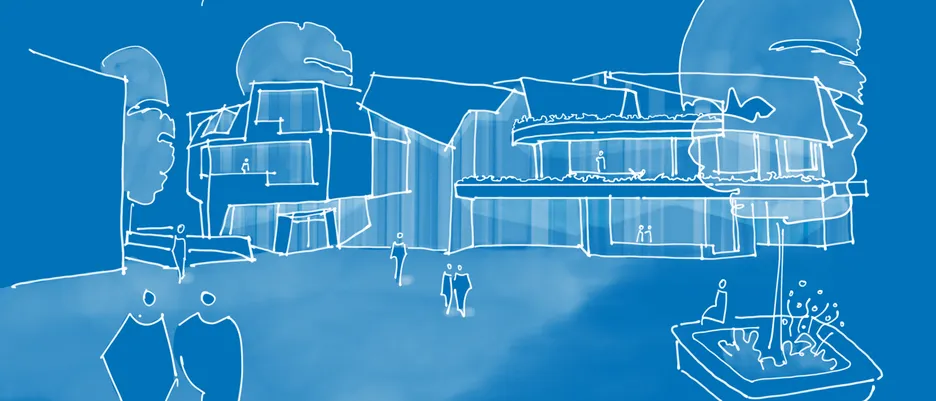Realization of a Nearly Zero Energy Standard for the "Freie Waldorfschule Uhlandshöhe" in Stuttgart
The new construction of the upper school building of the Waldorf School in Stuttgart was handled in an integral planning process. Architects, building physicists, energy, heating, ventilation, sanitary and electrical planners worked together with planners from the other trades and in close coordination with the client and the users on a solution with the central goal of a sustainable building with a high quality of living and a low requirement for fossil energy. The findings from the parallel research project "Development of exemplary new construction methods for the Waldofschule Uhlandshöhe in Stuttgart on a basis of measurements and analysis in new school buildings” were consistently incorporated into the planning.
The result was an architecturally attractive and appropriate building. In terms of urban development, the new building will on the one hand give the Waldorf School a new face towards the city due to its hilly location, and on the other hand it will not appear too prominent towards the inner courtyard and therefore, will not further aggravate the cramped situation.
Architecturally, it fits harmoniously into the existing ensemble, yet it has an expression that does justice to the Waldorf School's orientation towards anthroposophy in a contemporary aesthetic and artistic way. In this way, the energy efficiency measures were not superimposed on an existing building design, but are rather an integral part of the architecture, so that a Nearly Zero Energy Standard can be achieved in an economical way.
The planning process was accompanied from the very beginning by dynamic simulation calculations which quantify the efficiency of various measures and prove the user comfort in the classrooms. The building design supports for example natural wind and thermally driven ventilation through its appropriate form. At the same time, the façade design was optimized for an optimized use of glare-free daylight. The natural ventilation of the school was mostly preferred to a central mechanical ventilation system in order to keep the electricity demand and especially the immense operating costs and maintenance requirements low. The combination of this ventilation strategy with the building design is almost the most important feature of the school and manifests itself in the central atrium. It is both a social meeting place and a ventilation centre, as it serves as the "lung" of the Waldorf School. The natural preconditioning of the supply air takes place via an earth channel system and exits in the atrium. In winter as well as in summer (during the day), the supply air is preheated or precooled by the soil. Active mechanically operated overflow elements in the door area of the classrooms transport the air from the atrium into the respective classrooms (hybrid ventilation). The air flows out of the classrooms via horizontal window strips as flaps in the facade. In comparison to normal window ventilation, a high level of comfort can thus be guaranteed, as cold air drop in winter and high supply air temperatures in summer are avoided by opening windows.
A reversal of the ventilation direction occurs in summer (at night) and in the transitional period: the atrium then serves as a chimney and allows natural cross-ventilation of the classrooms. This reversal of direction is achieved by means of a motorised flap. In order to achieve a cost-effective, robust solution, the appropriate interaction has to be developed.
This system considers the client's requirement to achieve a high level of energy efficiency for the building, while at the same time limiting the expenditure on technical equipment.
As a heat transfer system, static heating surfaces with thermostatic control should be implemented. These react quickly to the changing load requirements that occur during school operation. The required heat is supplied by the school's own, already existing local heating network.
The roof landscape with 456 m² will be covered with photovoltaic modules. They produce so much electricity that only about 1/3 is needed for artificial lighting and auxiliary power. The remaining surplus can be used by the school itself or fed into the public grid. The financing of this large area of PV is largely possible due to the savings made by not using the mechanical ventilation system.
The high electricity surplus also has a positive effect on the energy balance of the Waldorf School. In balance terms, almost the entire heating requirement can be covered, so that in total a primary energy requirement of only 3.5 kWh/m²a is generated and a Nearly Zero Energy Standard is achieved.
